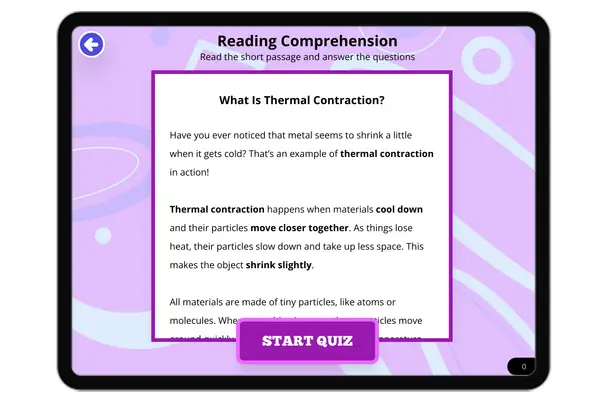What Is an Exothermic Reaction? — Passage
Have you ever sat near a campfire and felt its heat? That’s an example of an exothermic reaction in action.
An exothermic reaction is a chemical reaction that releases energy, usually in the form of heat or light. These reactions cause the surroundings to warm up because energy is given off as the reaction happens.
A great example of an exothermic reaction is burning wood. When wood burns, it combines with oxygen in the air and gives off heat and light. This reaction is not only warm to the touch, but also bright, like in a fire.
Another example is fireworks. When they explode in the sky, they release energy all at once, producing heat, light, sound, and color. That’s a very fast and exciting exothermic reaction!
Exothermic reactions happen in many places, not just in fires. Hand warmers often use chemical reactions that release heat to keep your hands warm in cold weather. Even when some substances are mixed together in a lab, the beaker may feel warm because of the energy released.
Exothermic reactions are the opposite of endothermic reactions, which absorb energy and make the surroundings cooler.
Understanding exothermic reactions helps scientists, engineers, and even cooks. It explains why fuels burn, how engines work, and why some materials heat up when mixed.
So, the next time you feel warmth from a reaction, you’re likely witnessing an exothermic change!
Fun Fact: Some hand warmers use iron powder and salt. When exposed to air, the iron reacts with oxygen in an exothermic reaction—just like rusting, but faster—and keeps your hands warm for hours!
What is an exothermic reaction?
A reaction that cools down the surroundingsA reaction that absorbs lightA reaction that releases energy as heat or lightA reaction that uses waterWhat do exothermic reactions do to their surroundings?
Make them colderMake them darkerMake them warmerFreeze themWhich of the following is an example of an exothermic reaction?
Ice meltingPhotosynthesisBurning woodMixing cold water and saltWhat do fireworks release during an exothermic reaction?
Ice and snowLight, heat, and soundOxygen onlyWater vaporWhat kind of reaction is used in hand warmers?
EndothermicCooling reactionExothermicEvaporationWhat is the opposite of an exothermic reaction?
Electric reactionCombustion reactionEndothermic reactionCooling reactionWhy do scientists and engineers study exothermic reactions?
To grow plants fasterTo understand heat and energy in reactionsTo make cold packsTo reduce lightWhat happens to energy during an exothermic reaction?
It is stored for laterIt disappearsIt is released into the surroundingsIt is trapped inside the object










